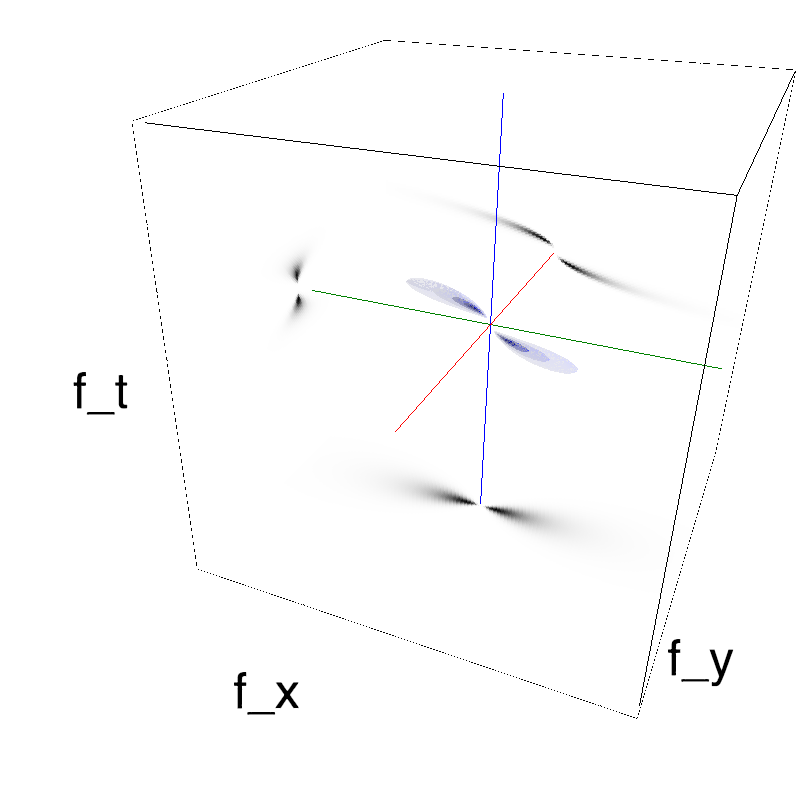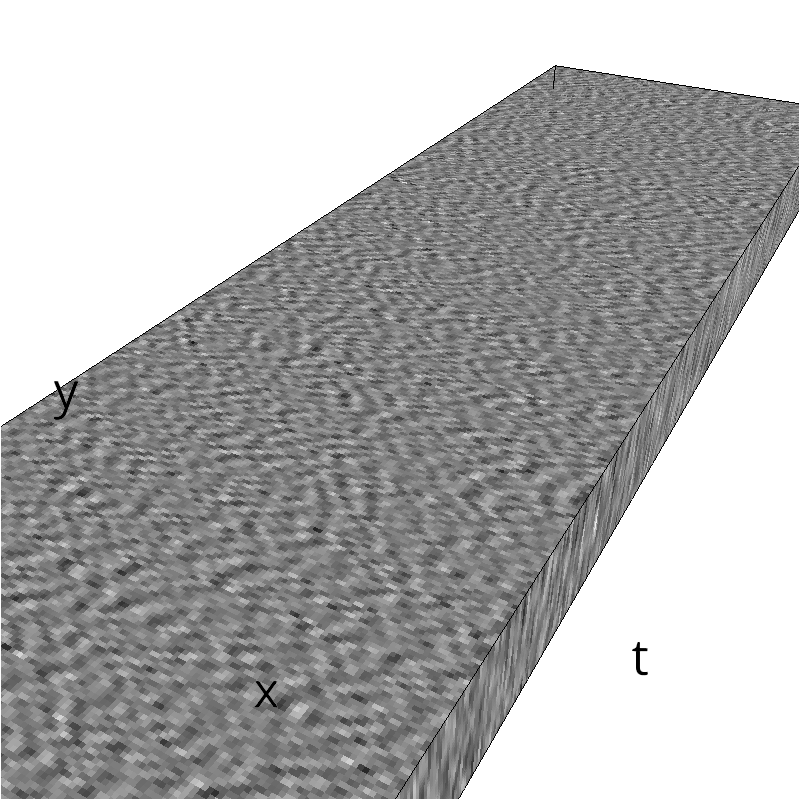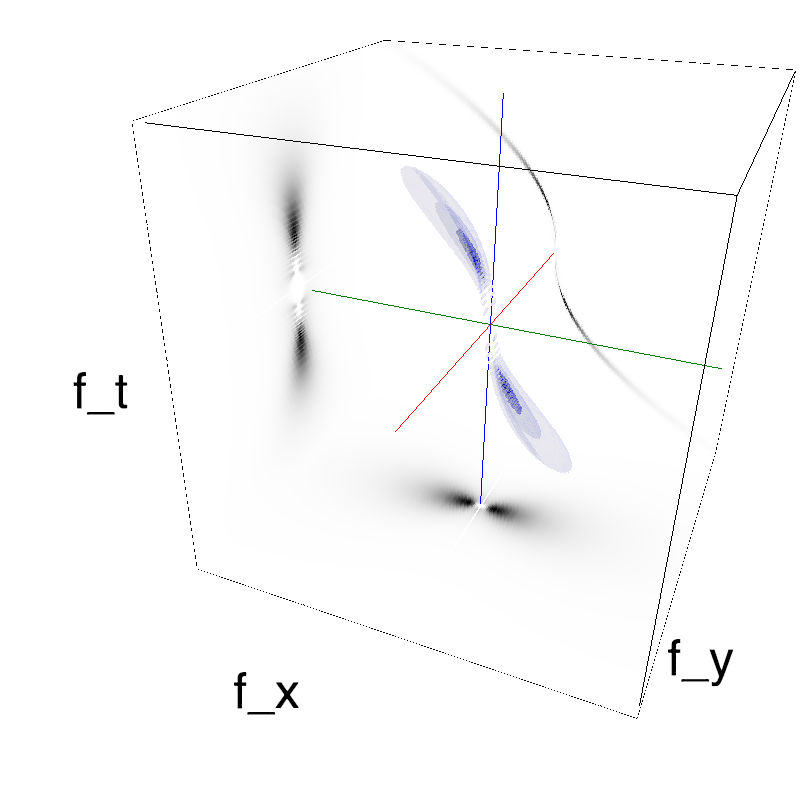élasticité - scénario vague
L'installation Elasticité dynamique agit comme un filtre et génère de nouveaux espaces démultipliés, comme un empilement quasi infini d'horizons. Par principe de réflexion, la pièce absorbe l'image de l'environnement et accumule les points de vue ; le mouvement permanent requalifie continuellement ce qui est regardé et entendu.
Ce post implémente une configuration implémentant une vague de propagation.
In [1]:
%load_ext autoreload
%autoreload 2
In [2]:
import matplotlib
matplotlib.use('nbagg')
%matplotlib inline
matplotlib.rcParams['figure.max_open_warning'] = 400
%matplotlib inline
%config InlineBackend.figure_format='retina'
import matplotlib.pyplot as plt
#%config InlineBackend.figure_format = 'svg'
vague gravitationnelle¶
In [3]:
name = 'waves'
vext = '.mp4'
import os
import numpy as np
import MotionClouds as mc
mc.N_X, mc.N_Y, mc.N_frame = 128, 32, 512
fx, fy, ft = mc.get_grids(mc.N_X, mc.N_Y, mc.N_frame)
theta, B_theta, B_wave = 0., np.pi/8., .5
#alpha, sf_0, B_sf, B_V = 2., .25, .3, 2.
alpha, sf_0, B_sf, B_V = 2., .2, .1, 3.
seed = 1234565
#V_X, V_Y, g = .5, 0., .1
V_X, V_Y, g = .5, 0., 2
loggabor=True
B_v = .025
def envelope_gravity(fx, fy, ft, B_wave, g=.1):
"""
Gravitational envelope:
selects the plane corresponding to the speed (V_X, V_Y) with some thickness B_V
"""
k = fx*V_X+fy*V_Y
env = np.exp(-.5*(((ft/.5)**2-g*np.sqrt(((k/.5)**2)))**2/(B_wave*mc.frequency_radius(fx, fy, ft, ft_0=np.inf))**2))
env *= (ft*k) < 0
return env
def envelope_gabor_wave(fx, fy, ft, B_wave, V_X=mc.V_X, V_Y=mc.V_Y,
B_V=mc.B_V, B_v=1., sf_0=mc.sf_0, B_sf=mc.B_sf, loggabor=mc.loggabor,
theta=mc.theta, B_theta=mc.B_theta, alpha=mc.alpha):
"""
Returns the Motion Cloud kernel
"""
envelope = mc.envelope_gabor(fx, fy, ft, V_X=V_X, V_Y=V_Y,
B_V=B_V, sf_0=sf_0, B_sf=B_sf, loggabor=loggabor,
theta=theta, B_theta=B_theta, alpha=alpha)
envelope *= envelope_gravity(fx, fy, ft, B_wave=B_wave)
return envelope
name_ = name + '_low'
mc_wave = envelope_gabor_wave(fx, fy, ft, V_X=1., V_Y=0., B_wave=B_v, B_V=B_V, theta=theta, B_theta=B_theta, sf_0=sf_0, B_sf=B_sf, alpha=alpha)
mc_wave = mc.envelope_gabor(fx, fy, ft, V_X=1., V_Y=0., B_V=B_V, theta=theta, B_theta=B_theta, sf_0=sf_0, B_sf=B_sf, alpha=alpha)
mc.figures(mc_wave, name_, vext=vext, seed=seed)
mc.in_show_video(name_)
Saving the corrresponding cloud as a nd.array:
In [4]:
vague_dense = mc.rectif(mc.random_cloud(mc_wave), contrast=1)
print(vague_dense.shape)
In [5]:
#mc_wave = envelope_gabor_wave(fx, fy, ft, V_X, V_Y, B_V, B_wave, sf_0, B_sf, theta, B_theta, alpha, g)
mc.figures(mc_wave, 'waves_impulse', seed=seed, impulse=True)
mc.in_show_video('waves_impulse')
In [6]:
vague_solo = mc.rectif(mc.random_cloud(mc_wave, seed=seed, impulse=True), contrast=1)
print(vague_solo.shape)
transforme la vague 2D sur les lames¶
In [7]:
def vague_animate(z, x_offset=0, y_offset=0, N_lame = 25, t_offset=0, N_steps = 512):
import matplotlib.pyplot as plt
import matplotlib.animation as animation
from IPython.display import HTML
fig, ax = plt.subplots(figsize=(15, 3))
x = np.arange(0, N_lame) # x-array
def vague(i):
return z[x_offset:(x_offset+N_lame), y_offset, t_offset+i]
def animate(i):
line.set_ydata(vague(i)) # update the data
return line,
#Init only required for blitting to give a clean slate.
def init():
line.set_ydata(np.ma.array(x, mask=True))
return line,
line, = ax.plot(x, vague(0))
ax.set_xlim([0, N_lame-1])
ax.set_ylim([0, 1])
anim = animation.FuncAnimation(fig, animate, np.arange(1, N_steps), init_func=init,
interval=25, blit=True)
return HTML(anim.to_html5_video())
In [8]:
vague_animate(vague_dense)
Out[8]:
In [9]:
vague_animate(vague_solo, x_offset=vague_solo.shape[0]//2-25//2, y_offset=vague_solo.shape[1]//2, t_offset=0, N_steps = vague_solo.shape[-1])
Out[9]:
In [10]:
vague_animate(vague_solo, x_offset=vague_solo.shape[0]//2-25//2, y_offset=vague_solo.shape[1]//2, t_offset=vague_solo.shape[-1]//4, N_steps=vague_solo.shape[-1]//2)
Out[10]:
In [11]:
vague_animate(vague_solo, x_offset=vague_solo.shape[0]//2-25//2, y_offset=vague_solo.shape[1]//2,
t_offset=vague_solo.shape[-1]*3//8, N_steps=vague_solo.shape[-1]//4)
Out[11]:
Saving as a scenario¶
In [12]:
%%writefile ../scenario_line_vague.py
#!/usr/bin/env python
# -*- coding: utf8 -*-
import elasticite as el
import numpy as np
def make_vague(impulse=False):
name = 'waves'
import os
import numpy as np
import MotionClouds as mc
mc.N_X, mc.N_Y, mc.N_frame = 128, 32, 512
fx, fy, ft = mc.get_grids(mc.N_X, mc.N_Y, mc.N_frame)
theta, B_theta, B_wave = 0., np.pi/8., .1
alpha, sf_0, B_sf, B_V = 2., .25, .3, 2.
alpha, sf_0, B_sf, B_V = 1., .1, .3, 2.
seed = 1234565
V_X, V_Y, g = .5, 0., .1
V_X, V_Y, g = .5, 0., 2
loggabor=True
B_v = .025
def envelope_gravity(fx, fy, ft, B_wave, g=.1):
"""
Gravitational envelope:
selects the plane corresponding to the speed (V_X, V_Y) with some thickness B_V
"""
k = fx*V_X+fy*V_Y
env = np.exp(-.5*(((ft/.5)**2-g*np.sqrt(((k/.5)**2)))**2/(B_wave*mc.frequency_radius(fx, fy, ft, ft_0=np.inf))**2))
env *= (ft*k) < 0
return env
def envelope_gabor_wave(fx, fy, ft, B_wave, V_X=mc.V_X, V_Y=mc.V_Y,
B_V=mc.B_V, B_v=1., sf_0=mc.sf_0, B_sf=mc.B_sf, loggabor=mc.loggabor,
theta=mc.theta, B_theta=mc.B_theta, alpha=mc.alpha):
"""
Returns the Motion Cloud kernel
"""
envelope = mc.envelope_gabor(fx, fy, ft, V_X=V_X, V_Y=V_Y,
B_V=B_V, sf_0=sf_0, B_sf=B_sf, loggabor=loggabor,
theta=theta, B_theta=B_theta, alpha=alpha)
envelope *= envelope_gravity(fx, fy, ft, B_wave=B_wave)
return envelope
B_v_low, B_v_high = .025, .1
mc_vague = envelope_gabor_wave(fx, fy, ft, V_X=1., V_Y=0., B_wave=B_v_low, B_V=B_V, theta=theta, B_theta=B_theta, sf_0=sf_0, B_sf=B_sf, alpha=alpha)
return mc.rectif(mc.random_cloud(mc_vague, seed=seed, impulse=impulse))
class EdgeGrid(el.EdgeGrid):
def __init__(self, vague, x_offset=0, y_offset=0, t_offset=0, N_steps = 256, damp_tau=5., **kwargs):
#super(el.EdgeGrid.__init__(self))
#super(el.EdgeGrid, self).__init__(**kwargs)
el.EdgeGrid.__init__(self, **kwargs)
#print (self.verb, kwargs)
self.vague = vague
self.x_offset = x_offset
self.y_offset = y_offset
self.t_offset = t_offset
self.N_steps = N_steps
#print(self.x_offset, self.y_offset, self.t_offset)
#print(self.z.shape)
self.damp_tau = damp_tau
def update(self):
if self.structure: N_lame = self.N_lame-self.struct_N
else: N_lame = self.N_lame
damp = lambda t: 1. - np.exp(-np.abs(np.mod(t+self.period/2, self.period)-self.period/2)/self.damp_tau)
N_periods = 1
i = np.mod(np.int(self.t/self.period * self.vague.shape[2] / N_periods), self.vague.shape[2])
surface = np.zeros_like(self.lames[2, :N_lame])
#for k, amp in zip([-2, -1, 0, 1, 2], [.125, .25, .5, .25, .125]):
# surface += amp * self.vague[self.x_offset:(self.x_offset+N_lame), self.y_offset, self.t_offset+i+k]
surface = self.vague[self.x_offset:(self.x_offset+N_lame), self.y_offset, self.t_offset+i]
surface = np.convolve(surface, np.arange(5), mode='same')
dsurface = np.gradient(surface)
dsurface *= np.bartlett(N_lame)
#print(dsurface.mean(), dsurface.max(), damp(self.t))
dsurface /= np.abs(dsurface).max()
dsurface *= np.tan(np.pi/32) # maximum angle achieved
self.lames[2, :N_lame] = np.arctan(dsurface)*damp(self.t)
if __name__ == "__main__":
import sys
if len(sys.argv)>1: mode = sys.argv[1]
else: mode = 'both'
vague_dense = make_vague(impulse=False)
period = 512./30
e = EdgeGrid(N_lame=25, grid_type='line', mode=mode,
verb=False, period=period, filename='mat/line_vague_dense.npy',
vague = vague_dense,
x_offset=0, y_offset=0, t_offset=0, N_steps=512)
# running the code
el.main(e)
In [13]:
%cd ..
!rm mat/line_vague_dense.npy
%run scenario_line_vague.py writer
%cd posts
In [14]:
z = np.load('../mat/line_vague_dense.npy')
print(z.shape)
fig, ax = plt.subplots(figsize=(15, 3))
#_ = ax.plot(z[:, 0])
_ = ax.plot(z[:, 0], z[:, 1:])
In [15]:
%%writefile ../scenario_line_vague_solo.py
#!/usr/bin/env python
# -*- coding: utf8 -*-
import elasticite as el
import numpy as np
from scenario_line_vague import make_vague, EdgeGrid
if __name__ == "__main__":
import sys
if len(sys.argv)>1: mode = sys.argv[1]
else: mode = 'both'
period = 512./30
vague_solo = make_vague(impulse=True)
e_solo = EdgeGrid(N_lame=25, grid_type='line', mode=mode,
verb=False, period=period, filename='mat/line_vague_solo.npy',
vague = vague_solo,
x_offset=vague_solo.shape[0]//2-25//2, y_offset=vague_solo.shape[1]//2,
t_offset=0, N_steps=512)#t_offset=vague_solo.shape[-1]*3//8, N_steps=vague_solo.shape[-1]//4)
# running the code
el.main(e_solo)
In [16]:
%cd ..
%run scenario_line_vague_solo.py writer
%cd posts
In [17]:
z = np.load('../mat/line_vague_solo.npy')
fig, ax = plt.subplots(figsize=(15, 3))
#_ = ax.plot(z[:, 0])
_ = ax.plot(z[:, 0], z[:, 1:])
In [ ]:
git¶
In [18]:
!git s
In [19]:
!git commit -am' scenario vague '
In [20]:
! git push



